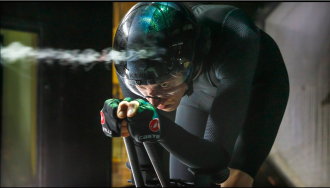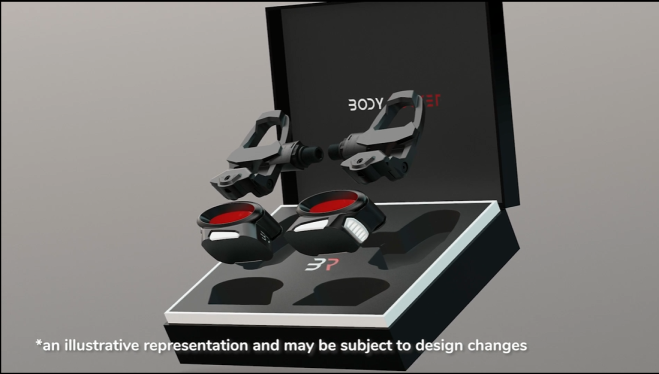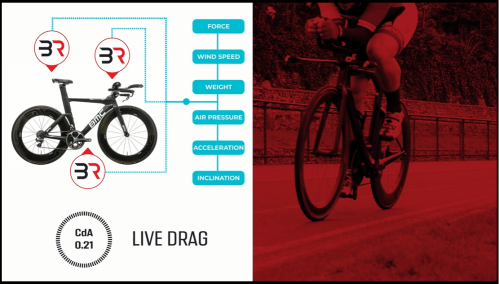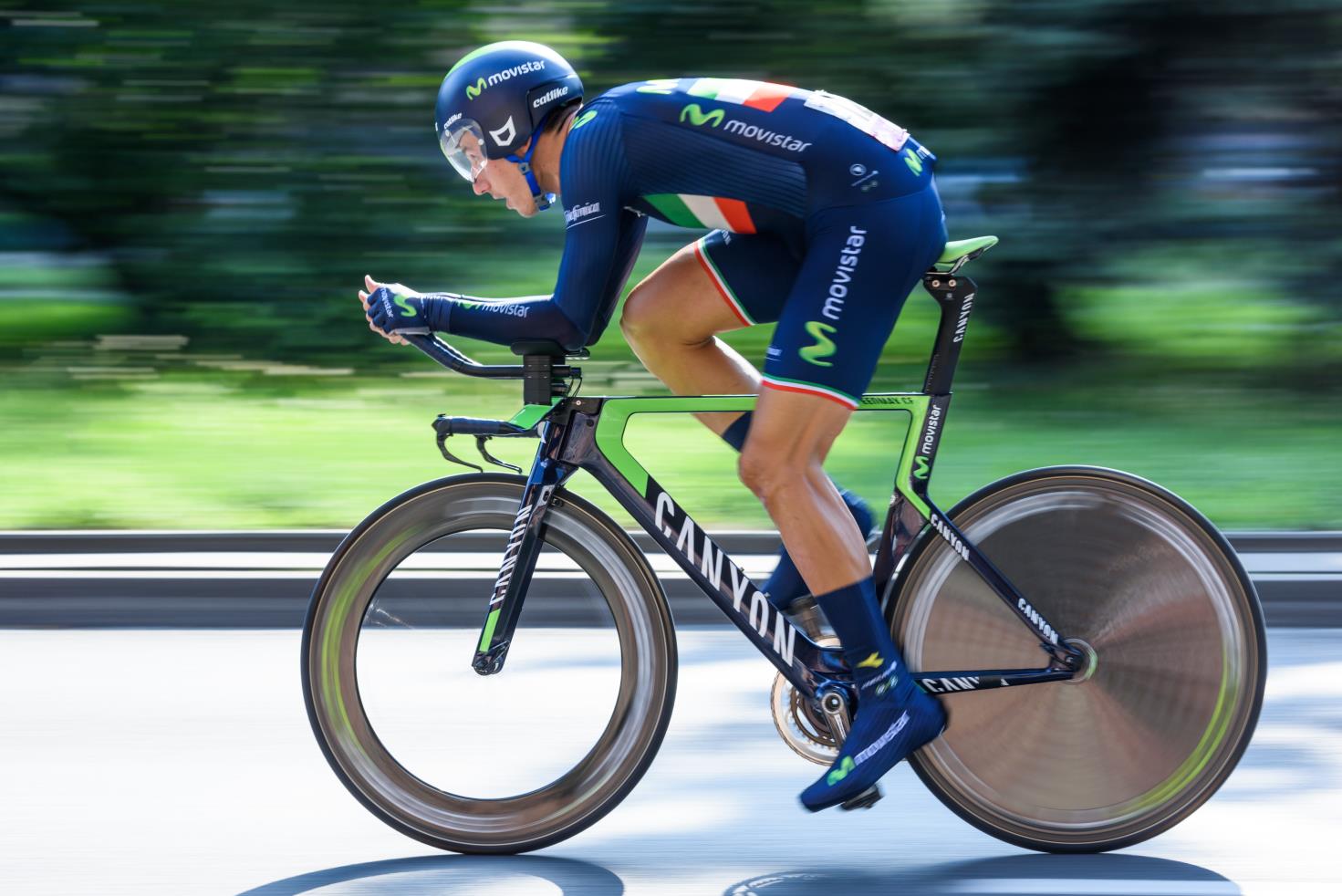Body Rocket live Aerodynamic data - could this be a Game Changer for Triathletes?
 Karen Parnell
January 31, 2023
Karen Parnell
January 31, 2023
Body Rocket live Aerodynamic data - could this be a game changer for triathletes?
As triathletes we know that the biggest chunk of the race is the cycling leg and optimising performance and speed here is essential.
Bike power meters constantly monitoring power output throughout your race and training and are now very common and can help you get the most from your cycle training and race. So we can all appreciate how technology can give us very useful real time date to help us perform better on the bike leg of a triathlon.
We are always striving to shave time from the bike leg so getting into an efficient aero position on a triathlon TT bike with a bike fit is a good idea to go as fast as we can. Many professional athletes also have the luxury of using a wind tunnel to test out new aerodynamic configurations, clothing fabrics, plus bike geometry, aero helmets, lightweight materials and components.
Ole Aleksander Bu is coach to both world champions Kristian Blummenfelt and Gustave Eden and he says:
"About 50 percent of a triathlon takes place on a bicycle and then the greatest force you're fighting against is aerodynamics," says Bu, who himself has experience from flying gliders, sailing, and cycling, which has given him particularly good insight into the field. "It gives me an understanding of how we can manipulate the aerodynamics in a completely different way than if I had only done it by the book."
In 2021 the Ironman world championships took place in St. George in Utah, instead of Hawaii. Kristian Blummenfelt won the gold medal at this event. It turned out that Blummenfelt lost up to 90 percent of generated power because of air resistance on the bike.
This proves that even with skinsuits, bike add-ons to improve airflow and a wind tunnel optimised body position on the bike you can still loose generated power without continuous feedback.
Continuous monitoring of power output on the bike was a game changer in 1989 and continuous monitoring of aerodynamics and air flow around your bike and body could be the game changer for 2023 – enter Body Rocket!

Body Rocket testing in a wind tunnel Source: Body Rocket
Get your FREE 31 Structured Cycling Sessions and Training Plan
What is Body Rocket?
Right now, the best method for optimising your drag is to get it measured in a wind tunnel. Often the advice is quite subtle (roll your shoulders, bring your head down slightly), leaving you wondering if you’re holding your position the next day when you’re riding outside. The whole wind tunnel model also presumes you remain in one static position while cycling, and often in one specific wind condition. But what happens when you get fatigued? What happens up and down hills? What happens when you are cornering, or you have a huge side wind?
Body Rocket aims to change this entire model. Their system constantly collects data about your aerodynamics in a whole range of different wind conditions. This means they can build a much more complete picture of a cyclist’s aerodynamics than is practical in a wind tunnel. They can help you understand, for example, how well you can maintain a position as you become more fatigued during an event, so you can make better decisions about set-up and pacing strategies.
The real-time component will be increasingly useful as you learn what aerodynamic numbers you can hold, as well as helping you make decisions about when and how to adjust your position as the conditions change. With the present model it’s assumed a cyclist has one position for all conditions. With a more complete knowledge of your aerodynamics, they expect to find that the optimal position for a headwind is different than the optimal position for a crosswind, for example.
Because the aerodynamics of a cyclist’s body accounts for ~80% of all the forces a cyclist is pushing against this is an area where significant performance gains are still possible.
Currently the Body Rocket technology works with Garmin, but they are talking with other bike head unit suppliers. Also, there’s a draft ANT+ standard for aero meters so hopefully in the near future it will become something all computers can support.
What bikes are compatible with Body Rocket?
Body Rocket will fit any standard 31.8mm bar that a normal aero extension would fit and any seat post that clamps to a 7mm saddle rail.
In addition, the following integrated cockpits will be supported.
- BMC Time Machine Disc ONE, Time Machine ONE
- Argon 18 E-119 Tri
- Canyon Speedmax CFR, CF SLX
- Ceepo Shadow
- Cervelo PX, P3X, P5
- Giant Trinity Advanced Pro
- Quintana Roo PRSIX, PRFIVE
- Scott Plasma Premium, Plasma RC
- Specialized Shiv
- Trek Speed Concept

Body Rocket Components Source: Body Rocket
Get your FREE 31 Structured Cycling Sessions and Training Plan
What does Body Rocket mean to racing?
Aerodynamics is important to you as a triathlete because it affects the amount of drag you experience while cycling, which can significantly impact your speed and overall race time. By reducing drag through aerodynamic positioning, gear, and equipment, you can improve your performance and save energy for the other two legs of the race.
A wind tunnel tries to replicate a perfect scenario and are costly to hire. Race day weather and conditions are not a perfect scenario!
Body Rocket’s patented technology aims to change this entire model. With constant data collection it’s possible to get insights into a range of new metrics. Over time they can build up a picture of a cyclist’s aerodynamics that goes well beyond what is practical in a wind tunnel by accounting for a full range of wind conditions.
They can also help a triathlete understand their ability to maintain their aerodynamics as they fatigue over the course of an event, something else that’s not practical with existing methods. This is all the behind-the-scenes big data analysis, and it help triathletes make better decisions about set-up and pacing strategies for their events.
When can I get my hands on Body Rocket and how much does it cost?
Body Rocket intends to follow a similar pricing arc to that of power meters. The initial product, which includes a power meter, will launch at a premium - £1499-£1999. As with power meters, they expect their devices to see a gradual downward trend due to increases in volume and decreases in the cost of consumer electronics components.
The product will be available to purchase at the end of 2023. The kit will include a sensor mounted on the aerobar riser, seat post inserts and instrumented pedals. It will have a ConnectIQ App to provide real time feedback on a Garmin device and web interface for more detailed information on your PC. They will measure force, wind speed, weight, air pressure, acceleration, and inclination which gives you live Coefficient of Aerodynamic Drag (CDA).

Body Rocket: 3 Sensors and 6 Metrics = Live Drag Data Source: Body Rocket
Get your FREE 31 Structured Cycling Sessions and Training Plan
Real Time Aerodynamic Data – the Game Changer
Body Rocket will have a big impact on how bike fitters and coaches help their athletes get into the best position on the bike even when they are fatigued and in changing race conditions. For athletes they can adjust their position during training and racing to avoid wasting the power they develop on the bike.
But as with all technology such as power meters not every athlete or coach will be able to afford this technology. So, for age group triathletes race results will not only come down to natural ability, how hard and intelligently they train, time they have to train but also how much disposable income they have.
“I am super excited to be partnering with Body Rocket. I have confidence in my performance at Kona later this year but it’s important to always stay on the cutting edge of technology. Having this next-level data about aerodynamics, in real-time, will help to identify improvements we can’t currently evaluate.”
Kristian Blummenfelt, Olympic and World Champion gold medallist and reigning Ironman 70.3 World Champion
Gustav Iden, Kristian Blummenfelt and Olav Aleksander Bu talking about Body Rocket
Get your FREE 31 Structured Cycling Sessions and Training Plan
Find out more about Body Rocket here.
If you want some cycling training inspiration you can download a free training plan with 31 different training sessions for Zwift, TrainerRoad and Rouvy.
Karen Parnell is a Level 3 British Triathlon and IRONMAN Certified Coach, 8020 Endurance Certified Coach, WOWSA Level 3 open water swimming coach and NASM Personal Trainer and Sports Technology Writer.
Karen is currently studying for an MSc in Sports Performance Coaching at the University of Stirling.
Need a training plan? I have plans on TrainingPeaks and FinalSurge:
I also coach a very small number of athletes one to one for all triathlon and multi-sport distances, open water swimming events and running races, email me for details and availability. Karen.parnell@chilitri.com
Get your FREE Guide to Running Speed and Technique
Get your FREE Swim Workouts for Triathletes E-book
Get your FREE Open Water Swimming Sessions E-Book
Get your FREE 31 Structured Cycling Sessions and Training Plan
FAQ: Body Rocket
How exactly will Body Rocket help me improve my aerodynamics?
Right now, the best method for optimising your drag is to get it measured in a wind tunnel. Often the advice is quite subtle (roll your shoulders, bring your head down slightly), leaving you wondering if you’re holding your position the next day when you’re riding outside. The whole wind tunnel model also presumes you remain in one static position while cycling, and often in one specific wind condition. Of course, that’s not so.
Body Rocket aims to change this entire model. Our system constantly collects data about your aerodynamics in a whole range of different wind conditions. This means we can build a much more complete picture of a cyclist’s aerodynamics than is practical in a wind tunnel. We can help you understand, for example, how well you can maintain a position as you become more fatigued during an event, so you can make better decisions about set-up and pacing strategies.
The real-time component will be increasingly useful as you learn what aerodynamic numbers you can hold, as well as helping you make decisions about when and how to adjust your position as the conditions change. With the present model it’s assumed a cyclist has one position for all conditions. With a more complete knowledge of your aerodynamics we expect to find that the optimal position for a headwind is different than the optimal position for a crosswind, for example.
Will you product only connect to a Garmin computer?
Our goal is to make aerodynamics accessible to as many people as possible so we’re certainly not trying to limit which computers our system works with! Right now there’s no standard for communicating aero data to a cycle computer so we’re reliant on those companies to support us. Garmin offers the Connect IQ system that allows new sensor innovations to work with them so they’re the go-to option.
We are talking to other cycle computer manufacturers, and may even be announcing another partner soon. Also, there’s a draft ANT+ standard for aero meters so hopefully in the near future it will become something all computers can support.
What is the envisaged unit price range for retail sales?
Body Rocket intends to follow a similar pricing arc to that of power meters. The initial product, which includes a power meter, will launch at a premium - £1499-£1999. As with power meters, we expect our devices to see a gradual downward trend due to increases in volume and decreases in the cost of consumer electronics components
When will be able to buy Body Rocket?
We will be launching Body Rocket to the mainstream market and making the device commercially available towards the end of 2023.
#traithlontrainingplans #runningtrainingplans #swimmingtrainingplans #triathlon #cycling

Photo by Jacek Dylag on Unsplash
